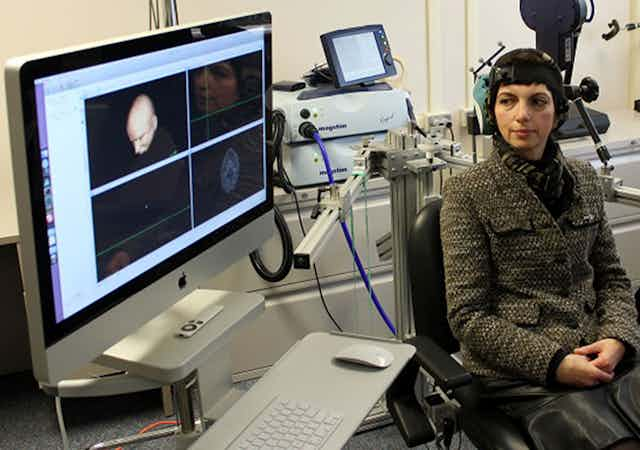Alzheimer’s disease is considered a global challenge of the century. Alzheimer’s disease is a thief. It comes and takes away the most precious memories with which people identify themselves. It is a very clever thief. People whom it affects don’t even remember what they have lost — they just feel lost; lost in space and time.
Alzheimer’s can affect anybody: intellectuals, professors, artists, musicians and handymen. My mother’s Alzheimer’s motivated me to start the very first Repetitive Transcranial Magnetic Stimulation (rTMS) treatment for Alzheimer’s in Canada.
The treatment is a non-invasive procedure that doesn’t involve any medication. This technology has been used to successfully treat depression, and it is also being studied for a number of other neurological conditions (for example, Parkinson’s, concussion and stroke).
In rTMS, an electromagnetic coil is placed on the scalp and uses magnetic pulses to cause neurons (nerve cells) in the brain to activate. The goal is to train the neurons to perform better in the future. The rTMS treatment has no, or only mild side effects: some people report a slight headache that is easily treated with a pain relief pill. And the risk of seizure is very low. (Individuals with a history of epilepsy and/or seizures are excluded from rTMS treatments for that reason.)
‘I remember’
Our very first patient was a challenging 82-year-old lady at a relatively advanced stage of Alzheimer’s, who hated the treatment. Every time I asked her if she had children, she said: “Not yet; I’m still in my twenties!”
On the seventh day of the treatment, in the middle of session, she asked us to stop. Her husband tried to calm her and convince her to continue, saying: “Didn’t you want to remember our children?”
She replied: “But I do remember Susan, Sam and Dona; why do I need this stupid treatment?”
That moment was what I had dreamed to see in my late mother: the way she used to be, even for a few minutes. That patient’s cognitive state did not show any significant improvement over the course of treatment. However, her short moment of memory retrieval encouraged me to continue the rTMS treatment study on others as well — particularly on those at earlier stages of Alzheimer’s.
One thing to note and remember is that Alzheimer’s is a progressive degenerative disease. If we intervene to plateau the state of the patient or slow the progression, that is indeed an improvement and can be considered a positive effect of the treatment.
In our pilot study, we gave a maintenance treatment every three months, to seven of our initial 10 participants, for up to a year and a half. Our results showed that as long as patients were receiving the treatment, they did not decline. Some improved slightly.
As soon as we stopped the treatment (due to lack of funding), all patients started to show some decline. Three of them declined so severely that, within three months of stopping treatment, they ended up in a nursing home and passed away within a year.
Overall, our pilot study and similar small-sample studies around the globe showed encouraging results of rTMS treatment on Alzheimer’s, especially when it was applied at early and moderate stages.
Encouraging steps to new Alzheimer’s treatment
As a result of those pilot studies, the Weston Brain Institute has now funded the very first large placebo-controlled double-blind study of rTMS treatment on Alzheimer’s. This is a collaboration of three universities: University of Manitoba, McGill University and Monash University. The team includes engineers, psychiatrists, clinical psychologists, neurologists and statisticians.
The study is to investigate the effect of rTMS treatment on Alzheimer’s patients at early and moderate stages. All participants have to be diagnosed by one of the study doctors. And there are several assessments for before and after treatment to assess the efficacy of the treatment and how long it may last.

While this current study is an encouraging step towards finding new treatment methods for Alzheimer’s, there are several other parameters in the rTMS treatment protocol whose investigation is not currently funded. They include: the method by which rTMS pulses are delivered, the location of the stimulation and the duration of treatment. Our current study investigates only the standard protocol of rTMS treatment. We hope after some preliminary results to apply for, and receive, more funding to continue the research.
The number of people affected by Alzheimer’s disease is on the rise. Alzheimer’s not only steals precious aspects of life from affected individuals but also from their families. Alzheimer’s forces the relatives of a patient to hopelessly watch a tragedy progress over a prolonged period of time, day after day.
Alzheimer’s disease is a multifold condition that requires a multidisciplinary approach for its treatment. It is only through our collective efforts that we can hope to find a solution for such a grim and dreadful disease. Despair may fly on the wings of morning; out of the heart of darkness comes the light.

